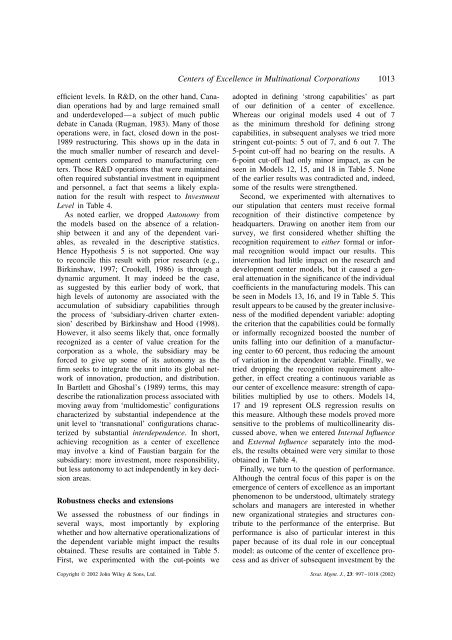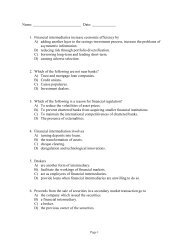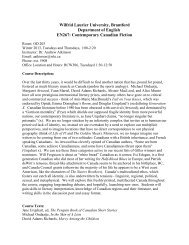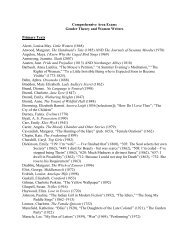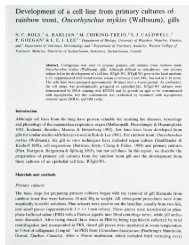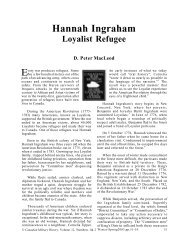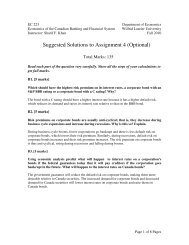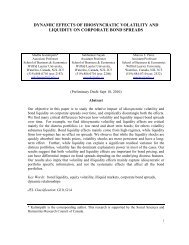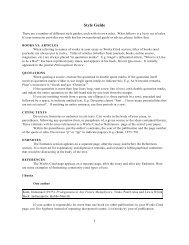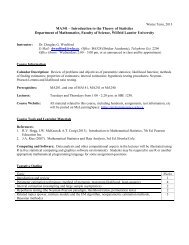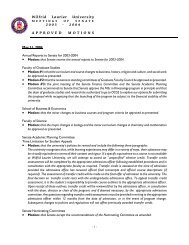CENTERS OF EXCELLENCE IN MULTINATIONAL CORPORATIONS
CENTERS OF EXCELLENCE IN MULTINATIONAL CORPORATIONS
CENTERS OF EXCELLENCE IN MULTINATIONAL CORPORATIONS
You also want an ePaper? Increase the reach of your titles
YUMPU automatically turns print PDFs into web optimized ePapers that Google loves.
Centers of Excellence in Multinational Corporations 1013efficient levels. In R&D, on the other hand, Canadianoperations had by and large remained smalland underdeveloped—a subject of much publicdebate in Canada (Rugman, 1983). Many of thoseoperations were, in fact, closed down in the post-1989 restructuring. This shows up in the data inthe much smaller number of research and developmentcenters compared to manufacturing centers.Those R&D operations that were maintainedoften required substantial investment in equipmentand personnel, a fact that seems a likely explanationfor the result with respect to InvestmentLevel in Table 4.As noted earlier, we dropped Autonomy fromthe models based on the absence of a relationshipbetween it and any of the dependent variables,as revealed in the descriptive statistics.Hence Hypothesis 5 is not supported. One wayto reconcile this result with prior research (e.g.,Birkinshaw, 1997; Crookell, 1986) is through adynamic argument. It may indeed be the case,as suggested by this earlier body of work, thathigh levels of autonomy are associated with theaccumulation of subsidiary capabilities throughthe process of ‘subsidiary-driven charter extension’described by Birkinshaw and Hood (1998).However, it also seems likely that, once formallyrecognized as a center of value creation for thecorporation as a whole, the subsidiary may beforced to give up some of its autonomy as thefirm seeks to integrate the unit into its global networkof innovation, production, and distribution.In Bartlett and Ghoshal’s (1989) terms, this maydescribe the rationalization process associated withmoving away from ‘multidomestic’ configurationscharacterized by substantial independence at theunit level to ‘transnational’ configurations characterizedby substantial interdependence. In short,achieving recognition as a center of excellencemay involve a kind of Faustian bargain for thesubsidiary: more investment, more responsibility,but less autonomy to act independently in key decisionareas.Robustness checks and extensionsWe assessed the robustness of our findings inseveral ways, most importantly by exploringwhether and how alternative operationalizations ofthe dependent variable might impact the resultsobtained. These results are contained in Table 5.First, we experimented with the cut-points weadopted in defining ‘strong capabilities’ as partof our definition of a center of excellence.Whereas our original models used 4 out of 7as the minimum threshold for defining strongcapabilities, in subsequent analyses we tried morestringent cut-points: 5 out of 7, and 6 out 7. The5-point cut-off had no bearing on the results. A6-point cut-off had only minor impact, as can beseen in Models 12, 15, and 18 in Table 5. Noneof the earlier results was contradicted and, indeed,some of the results were strengthened.Second, we experimented with alternatives toour stipulation that centers must receive formalrecognition of their distinctive competence byheadquarters. Drawing on another item from oursurvey, we first considered whether shifting therecognition requirement to either formal or informalrecognition would impact our results. Thisintervention had little impact on the research anddevelopment center models, but it caused a generalattenuation in the significance of the individualcoefficients in the manufacturing models. This canbe seen in Models 13, 16, and 19 in Table 5. Thisresult appears to be caused by the greater inclusivenessof the modified dependent variable: adoptingthe criterion that the capabilities could be formallyor informally recognized boosted the number ofunits falling into our definition of a manufacturingcenter to 60 percent, thus reducing the amountof variation in the dependent variable. Finally, wetried dropping the recognition requirement altogether,in effect creating a continuous variable asour center of excellence measure: strength of capabilitiesmultiplied by use to others. Models 14,17 and 19 represent OLS regression results onthis measure. Although these models proved moresensitive to the problems of multicollinearity discussedabove, when we entered Internal Influenceand External Influence separately into the models,the results obtained were very similar to thoseobtained in Table 4.Finally, we turn to the question of performance.Although the central focus of this paper is on theemergence of centers of excellence as an importantphenomenon to be understood, ultimately strategyscholars and managers are interested in whethernew organizational strategies and structures contributeto the performance of the enterprise. Butperformance is also of particular interest in thispaper because of its dual role in our conceptualmodel: as outcome of the center of excellence processand as driver of subsequent investment by theCopyright © 2002 John Wiley & Sons, Ltd. Strat. Mgmt. J., 23: 997–1018 (2002)


